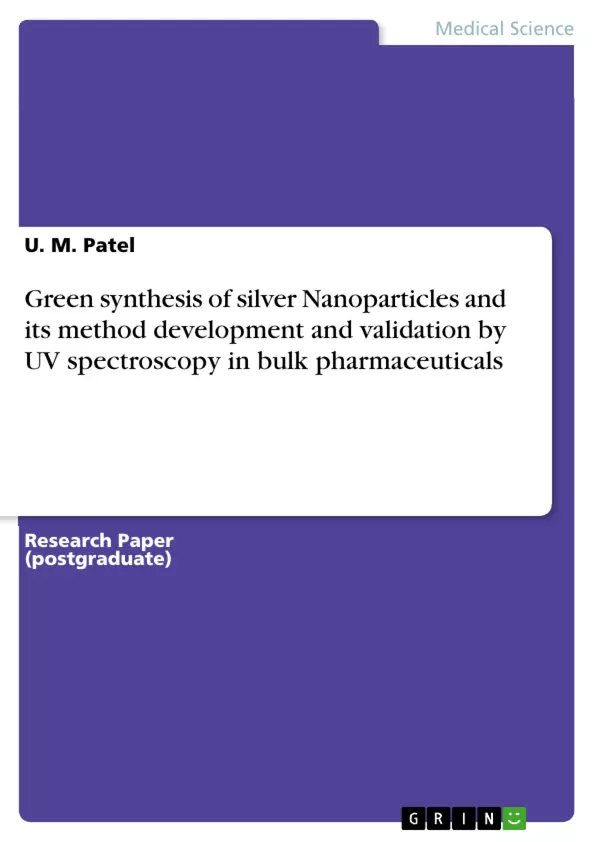In this study, we report the synthesis of Ag NPs by green synthesis process using Datura metel leaf extract as reducing agent. The final products characteristics were studied – optical, structural, surface morphology and elemental analysis.
Silver Nanoparticle has been recognized as a safe inorganic, antibacterial, nontoxic agent. Conventional synthesis of Silver Nanoparticle can generate toxic waste during the reaction process hence, this paper the green synthesis approach used and for synthesis of silver nanoparticle by using Datura metel leaf extract as a reducing agent. The change in colour of silver nitrate solution from colourless to brown was visual identification for formation of Silver Nanoparticle and shown the absorption at 447 nm. The synthesized Silver Nanoparticle were of size 180 nm analyse by SEM and further characetrised by FTIR where carboxylic peak was obtained at 1675 cm-1 as well as presence of alcoholic group and polyphenols. Further validated method was developed and linearity was found to be 0.995 and % RSD of validation parameters were found to be within the limit <2%.
A simple, lab scale, rapid, accurate, precised and sensitive spectroscopic method has been developed and validated as per ICH guideline for synthesized silver nanoparticle in bulk pharmaceuticals by UV vis spectrophotoscopy and which is applicable for routine analysis.
Inhaltsverzeichnis (Table of Contents)
- GREEN SYNTHESIS OF SILVER NANOPARTICLES AND ITS METHOD DEVELOPMENT AND VALIDATION BY UV SPECTROSCOPY IN BULK PHARMACEUTICALS
- Introduction
- Materials and Methods
- Results and Discussion
- Conclusion
- References
Zielsetzung und Themenschwerpunkte (Objectives and Key Themes)
The primary objective of this research is to develop and validate a simple, rapid, and cost-effective method for analyzing silver nanoparticles (Ag NPs) in bulk pharmaceuticals using UV-Vis spectrophotometry. The study focuses on a green synthesis approach utilizing Datura metel leaf extract as a reducing agent, minimizing the environmental impact compared to conventional methods.
- Green synthesis of silver nanoparticles using plant extracts
- Validation of a UV-Vis spectrophotometric method for Ag NPs analysis
- Comparison of green synthesis with conventional methods
- The potential applications of Ag NPs in pharmaceuticals
- Environmental considerations in nanoparticle synthesis
Zusammenfassung der Kapitel (Chapter Summaries)
- Introduction: The chapter introduces the importance of silver nanoparticles in various fields, particularly their antimicrobial properties and increasing commercial demand. It highlights the drawbacks of conventional synthesis methods, emphasizing the need for eco-friendly alternatives. The chapter introduces green synthesis using plant extracts as a promising approach.
- Materials and Methods: This chapter details the materials used in the study, including Datura metel leaves, silver nitrate, and methanol. It outlines the green synthesis process using Datura metel leaf extract as a reducing agent and describes the preparation of Ag NPs. The validation process of the UV-Vis spectrophotometric method is also presented.
- Results and Discussion: This chapter presents the findings of the study, including characterization of the synthesized Ag NPs using techniques like SEM and FTIR. It discusses the validation parameters of the UV-Vis method, such as linearity and precision, and analyzes the results in relation to the existing literature. The chapter also explores the potential applications of the developed method in pharmaceutical analysis.
Schlüsselwörter (Keywords)
The study focuses on the green synthesis of silver nanoparticles, using Datura metel leaf extract as a reducing agent, and the development and validation of a UV-Vis spectrophotometric method for the analysis of Ag NPs in bulk pharmaceuticals. The research aims to contribute to the development of eco-friendly and cost-effective analytical methods for the pharmaceutical industry.
- Arbeit zitieren
- U. M. Patel (Autor:in), 2019, Green synthesis of silver Nanoparticles and its method development and validation by UV spectroscopy in bulk pharmaceuticals, München, GRIN Verlag, https://www.hausarbeiten.de/document/1419236


